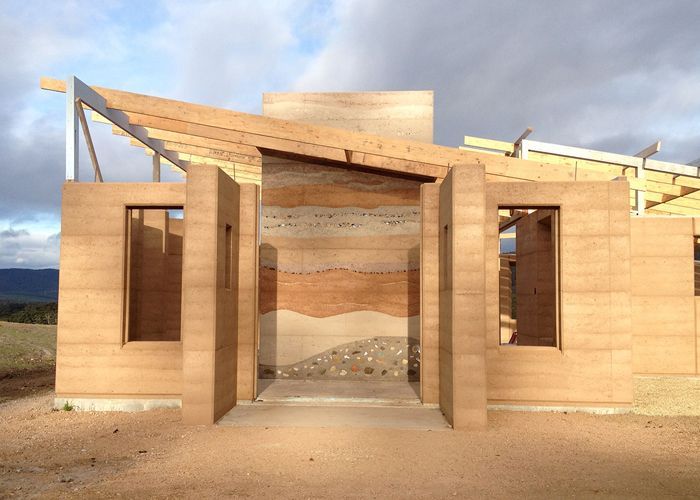An ancient building technique is gaining new fans: Rammed Earth Construction

Image Sourced From: Green Building Advisor
How familiar are you with construction methods and materials? The vast majority of buildings, both residential and commercial, are built around a frame made of dimensional lumber (standard 2x4 pieces of wood) or light-gauge steel. Other construction methods, such as bricks and reinforced or unreinforced concrete, are often used in conjunction with a frame.
However, these aren’t the only methods of construction available, nor are they the most environmentally friendly methods! For example, concrete has a significant environmental impact, as the cement industry is one of the main producers of the world’s CO2 emissions.
So, what other kinds of construction methods and materials are out there? Rammed earth is an ancient building technique that is just as applicable today as it was thousands of years ago. Not only is it applicable, but it also is sustainable and quite aesthetically pleasing. It is just one of many green building techniques. As buildings account for roughly one third of global greenhouse gas emissions, and play a significant role in our environmental health, it is worth paying attention to the benefits of green buildings for the environment and building occupants.
What is Rammed Earth?
Rammed earth is created through the compaction of a dampened mixture of subsoil which has the correct proportions of clay, sand, and gravel. If required, stabilizers such as a small amount of cement can be added to the mixture. This addition of a stabilizer is important, as common issues associated with rammed earth (such as external surface protection, water resistance, shrinkage, and strength) can be avoided by the use of stabilizers.

Image Sourced From: Pinterest - Ivan Turyk
Although cement isn’t the best building material due to its environmental impact, only around 6 to 8% of the rammed earth mixture will include cement. Additionally, lime or asphalt emulsions can be used as stabilizers as well.
Lastly, colour pigment can also be added to a rammed earth mixture in order to give a building a little something extra!
Rammed earth construction is thought to have originated in China and the Iberian Peninsula, as ancient buildings and structures which appear to have used the rammed earth construction technique can be found in these locations. For example, the original sections of the Great Wall of China have been built with rammed earth. When it comes to sustainable construction, sometimes it can be useful to look to the past in order to guide our current actions. After all, newer isn’t always better!
Rammed Earth Construction Methods
You may be wondering how rammed earth is actually used to build modern buildings. The first step is to build a temporary frame (called formwork) out of wood. This frame will act as a mould for the desired shape and dimensions of each wall. Small amounts of the rammed earth mixture are poured into the formwork and are then compressed to around 50 per cent of its original height with a pneumatic tamper. Compression is completed in batches in order to gradually build up the wall to its desired height. Once the mixture has dried and hardened, the formwork can be removed and the wall is finished.
One benefit of this method is that the completed walls have a lovely, layered pattern that looks like the perfect mix of intentional design and natural beauty that can only be found in nature!

Environmental Benefits
Along with the pleasing aesthetics, rammed earth construction offers many environmental benefits! These benefits have helped to increase the popularity of the rammed earth construction method as a sustainable way to construct our residential and commercial buildings. While there are currently no existing building codes for rammed earth construction in North America, countries such as Australia and New Zealand have formalized building codes.
1. Durable and strong
Once the rammed earth wall has dried, they typically have a load bearing capacity that is similar to concrete. This means that they are more than strong enough to be used comfortably as building materials. So don’t worry, rammed earth walls won’t crumble around you!
2. Low embodied energy
Embodied energy is the sum of all the energy that is required in order to make a building material. Embodied energy includes all processes related to the creation of the material at hand, including the resources that were extracted, the manufacturing process, as well as the transportation and delivery. Rammed earth buildings have low embodied energy, as the main material used to create the walls is often sourced right from the building site. Additionally, the finished product is easily recyclable, therefore further reducing its embodied energy.
3. High Thermal Mass
Thermal mass is the ability of a material to absorb and store heat energy. Rammed earth has high thermal mass, meaning that solar heat is able to be stored during the day. This heat is then radiated back out at night when internal temperatures begin to drop. Thus, a high thermal mass keeps buildings comfortable through the use of natural materials. For more information on solar design, check out these articles on passive solar design, passive house, and solar walls.
Stay connected with news and updates!
Join my mailing list to receive the latest news and updates. Your information will not be shared.

